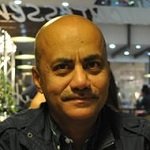To some extent the museum has replaced the church in our times, because now a large number of people across the world regularly visit museums instead
To some extent the museum has replaced the church in our times, because now a large number of people across the world regularly visit museums instead of going to places of worship. The ritual of spending Sunday at a museum of modern art reminds one of the custom of attending mass on Sunday morning. In the same lieu, art works have become sacred entities, so much so that the idea of destroying a painting by Vincent Van Gogh is as unthinkable, shocking and scandalous as desecrating a holy book. Actually, the painting is protected not only for its monetary value, but is regarded as one of the icons of our times, representing the triumph of Western/European (if not the Western) civilization.
Recently with the emergence of media, spread of its influence and increase in its power, different types of icons have evolved in the society. These include images of popular visual culture – which are part of advertisement, cinema, print and electronic media and social media; thus a whole new range of images and ideas has reached the general public’s imagination. In a way these visuals formulate, represent and present mythologies of our times. Connected to the culture of commodities, strategies of marketing and realm of entertainment these incorporate collective desires and common faith (the religion of globalization, which is equally adapted by multinational businesses and transnational terrorists) are much like the mythologies of past, which decoded the way a certain people lived.
These modern mythologies, which are not defined or definite, are the focus of our August issue. Adnan Madani and Aziz Sohail map and examine these in their essays, and discuss how these influence and shape our lives today. In her photo-essay, NashmiaHaroon captures another façade of these modern myths – found in our surroundings, but often neglected and ignored.
The profile section of ArtNow includes the studies of two personalities, who in their different areas have been involved with the ‘present’; either through using its visual forms in the work of art, or investigating it in other fields of knowledge and creativity. The reviews, book review and news of art events – as every month – are part of the present issue; but all these texts on art in a sense make another kind of modern mythology, since today, talking about art has become as important and potent as the making of art. ♦
Editorial
To some extent museum has replaced the churchin our times, because nowa large number of population across the world regularly visits museums instead of going to places of worship. The ritual of spending Sunday at a museum of modern art reminds of the custom of attending mass on Sunday morning. In the same lieu art works have become sacred entities, so much so that the idea of destroying a painting by Vincent Van Gogh is as unthinkable, shocking and scandalous as desecrating a holy book. Actually the painting is protected not for its monetary value only, but is regarded as one of the icons of our times, which represent triumph of Western/European (if not the Western) civilization.
Recently with the emergence of media, spread of its influence and increase in its power, different types of icons have evolved in the society. These include images of popular visual culture – which are part of advertisement, cinema, print and electronic media and social media; thus a whole new range of images and ideas has reached general public’s imagination. In a way these visuals formulate, represent and present mythologies of our times. Connected to the culture of commodities, strategies of marketing and realm of entertainment these incorporate collective desires and common faith (the religion of globalization, which is equally adapted by the multinational businesses and transnational terrorists) much like mythologies of past, which decode the way a certain people lived.
These modern mythologies, which are not defined or definite, are the focus of our August issue. Adnan Madani and Aziz Suhailmap and examine these in their essays, and discuss how these influence and shape our lives today. In her photo-essay too NashmiaHaroon captures another façade of these modern myths – found in our surroundings, but often neglected and ignored.
The profile section of Art Now Pakistan includes studies of two personalities, who in their different areas have been involved with the ‘present’; either through using its visual forms in the work of art, or investigating it in other fields of knowledge and creativity. The reviews, book review and news of art events – like every month – are part of present issue; but all these texts on art – in a sense make another kind of modern mythologies, since today talking about art has become as important and potent as the making of art.

QuddusMirza
Editor

COMMENTS